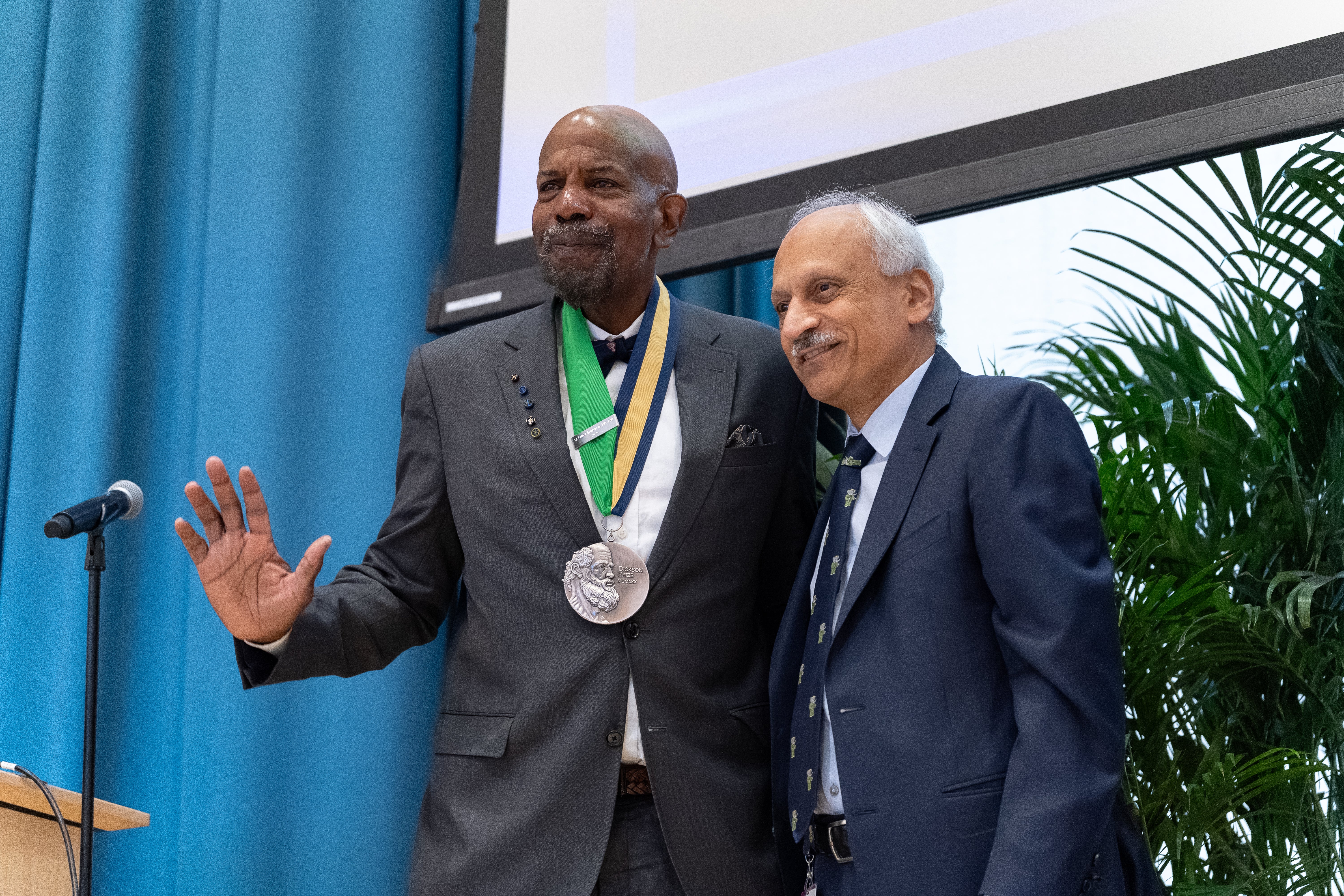 Photography by Rayni Shiring/University of Pittsburgh
Photography by Rayni Shiring/University of Pittsburgh
Scientists can already induce the regrowth of skin, bone and other tissues. The tantalizing next step is putting them all together for the “moonshot” of limb regeneration, says Cato T. Laurencin, chief executive officer of the Cato T. Laurencin Institute for Regenerative Engineering at the University of Connecticut.
Laurencin, the recipient of the 2025 Dickson Prize in Medicine, the University of Pittsburgh School of Medicine’s highest honor, discussed progress in using inductive materials in the field of regenerative engineering, which he pioneered, in his Dickson Prize lecture at Pitt on July 11, 2025. The prize is awarded annually to an American biomedical researcher who has made significant, progressive contributions to medicine. Many recipients have gone on to receive other major accolades, including the Nobel Prize and the Lasker Award.

Laurencin, who is a professor of chemical and biomolecular engineering, of materials science and engineering, and of biomedical engineering, UConn School of Engineering, is the Albert and Wilda Van Dusen Distinguished Professor of Orthopaedic Surgery at UConn School of Medicine.
His institute is internationally renowned for its work in musculoskeletal repair and regeneration. In welcoming him, Anantha Shekhar, John and Gertrude Petersen Dean, School of Medicine, noted that he completed his MD at Harvard and his PhD at the Massachusetts Institute of Technology at the same time, and then, while running a major MIT research lab, completed his orthopaedics residency.
“This is an amazing scientist, surgeon and leader that, right from the beginning, has been a shining star in the field,” Shekhar said.
He also has the distinction of having been knighted by the Governor General of St. Lucia under the auspices of King Charles III, adding “Sir Cato” to his list of titles.

Laurencin’s lecture, “Regenerative Engineering: Breakthroughs in Medicine,” outlined the ways scientists can already regenerate most tissues individually—bone, ligaments, blood vessels, nerves and skin. His lab has had success in combining those in its digit program for regenerating injured fingertips.
To put all the pieces together for heavy limb regeneration, his institute is working on what it calls the Hartford Engineering a Limb project, or HEAL.
“We know that a newt can regenerate an entire limb in seven to 10 weeks. And we need to harness that in terms of regenerative engineering, in terms of having this broad toolbox,” he said. Some of the approaches, he said, “can be really out of the box.”
Laurencin explained recent advances in regenerative engineering, highlighting the use of graphene composite matrices and calcium phosphate for bone and soft tissue regeneration. He’s enthusiastic about the use of synthetic artificial stem cells, which he calls SASC (pronounced “sassy”), as drivers for regeneration, particularly because of his success in using them for osteoarthritis treatment.
A panel discussion after his talk featured researchers in Pitt’s School of Medicine working in related areas, including Chandan Sen, associate vice chancellor for life sciences innovation and commercialization, health sciences, director, McGowan Institute for Regenerative Medicine, and professor of surgery; Allison Bean, assistant professor of physical medicine and rehabilitation and of orthopaedic surgery; and MaCalus Hogan, David Silver Professor and chair of orthopaedic surgery. Laurencin was a mentor of Hogan’s at the University of Virginia, inspiring him in his work and his fashion choices: both favor bowties.

Before his lecture, Laurencin toured the Bethel Musculoskeletal Research Center (BMRC) and the UPMC Rehabilitation Institute at UPMC Mercy Pavilion. At BMRC, Laurencin visited labs where researchers are studying and improving outcomes for musculoskeletal disorders. He learned about its new biobank, a comprehensive data repository designed to promote cross-institutional collaboration that has begun collecting patient samples.
At the UPMC Rehabilitation Institute, he toured the Rehab Neural Engineering Labs, where researchers are working to improve the lives of those with neurological conditions by deepening understanding of motor and sensory systems and developing technologies for rehabilitation therapies.
